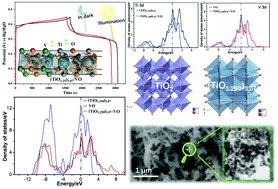当前位置:
X-MOL 学术
›
Dalton Trans.
›
论文详情
Our official English website, www.x-mol.net, welcomes your
feedback! (Note: you will need to create a separate account there.)
P-Functionalized and O-deficient TiOn/VOm nanoparticles grown on Ni foam as an electrode for supercapacitors: epitaxial grown heterojunction and visible-light-driven photoresponse
Dalton Transactions ( IF 3.5 ) Pub Date : 2020/03/03 , DOI: 10.1039/d0dt00317d Keyu Tao 1, 2, 3, 4, 5 , Lian Wang 1, 2, 3, 4, 5 , Yang Hai 1, 2, 3, 4, 5 , Yun Gong 1, 2, 3, 4, 5
Dalton Transactions ( IF 3.5 ) Pub Date : 2020/03/03 , DOI: 10.1039/d0dt00317d Keyu Tao 1, 2, 3, 4, 5 , Lian Wang 1, 2, 3, 4, 5 , Yang Hai 1, 2, 3, 4, 5 , Yun Gong 1, 2, 3, 4, 5
Affiliation

|
P–TiOn–VOm nanowires were grown on nickel foam (NF) via a one-pot hydrothermal method and by further vapor deposition/phosphorization method. It was found that low valence states of titanium oxide and deficient-oxygen coexist in P–TiOn–VOm/NF. Furthermore, (TiO1.25)3.07 (denoted as TiOn) and VO (denoted as VOm) possess similar structures and matched facets, and their epitaxial growth leads to the formation of TiOn/VOm heterostructure with a formation energy of −1.59 eV. P–TiOn–VOm/NF possesses good electron conductivity and electrons can be transferred from Ti to V centers, as evidenced by the DFT calculations and the XPS spectra. As a result, the specific capacity of P–TiOn–VOm/NF can reach 785 C g−1 at 1 A g−1 in the potential range of 0–0.55 V vs. Hg/HgO, which is much larger than those of VOm/NF, P–VOm/NF, and P–TiO2–VOm/NF. On the other hand, the TiOn/VOm heterostructure also favors the separation and transfer of photoinduced electrons and holes, and P–TiOn–VOm/NF exhibits visible-light-driven photoresponse. Under visible light illumination, the specific capacity of P–TiOn–VOm/NF is increased by 6.2% relative to that in the dark. Furthermore, the P–TiOn–VOm/NF//activated carbon (AC) asymmetric supercapacitor (ASC) shows an energy density of 37.2 W h kg−1 at a power density of 1 kW kg−1 and excellent cycling performance with 93.6% capacity retention after 10 000 cycles at 5 A g−1, which is comparable to and even superior to those of titanium oxides and vanadium oxides. A promising achievement has been proposed to improve the energy storage performance of P–TiOn–VOm through P-functionalization and O-deficiency in this work.
中文翻译:

在Ni泡沫上生长的P功能且缺O的TiOn / VOm纳米颗粒作为超级电容器的电极:外延生长的异质结和可见光驱动的光响应
P-TiO n -VO m纳米线通过一锅水热法和进一步的气相沉积/磷化法在泡沫镍(NF)上生长。结果发现,P-TiO n -VO m / NF共存低价态的氧化钛和缺氧态。此外,(TiO 1.25)3.07(表示为TiO n)和VO(表示为VO m)具有相似的结构和相匹配的面,并且它们的外延生长导致形成TiO n / VO m异质结构,形成能为-1.59 eV。P–TiO n –VO m/ NF具有良好的电子传导性,并且电子可以从Ti转移到V中心,这由DFT计算和XPS光谱证明。结果,P-TiO n -VO m / NF的比容量在0-0.55 V vs.的电势范围内,在1 A g -1下可以达到785 C g -1。Hg / HgO,比VO m / NF,P–VO m / NF和P–TiO 2 –VO m / NF大得多。另一方面,TiO n / VO m的异质结构也有利于光致电子和空穴的分离和转移,而P–TiO n -VO m/ NF表现出可见光驱动的光响应。在可见光照射下,相对于黑暗,P-TiO n -VO m / NF的比容量增加了6.2%。此外,P–TiO n –VO m / NF //活性炭(AC)不对称超级电容器(ASC)在1 kW kg -1的功率密度下显示出37.2 W h kg -1的能量密度,并具有出色的循环性能。在5 A g -1下进行1万次循环后,容量保持力达到93.6%,与钛氧化物和钒氧化物相当,甚至更好。已经提出了有希望的成就来改善P–TiO n –VO m的储能性能 通过P功能化和O缺乏在这项工作中。
更新日期:2020-04-08
中文翻译:

在Ni泡沫上生长的P功能且缺O的TiOn / VOm纳米颗粒作为超级电容器的电极:外延生长的异质结和可见光驱动的光响应
P-TiO n -VO m纳米线通过一锅水热法和进一步的气相沉积/磷化法在泡沫镍(NF)上生长。结果发现,P-TiO n -VO m / NF共存低价态的氧化钛和缺氧态。此外,(TiO 1.25)3.07(表示为TiO n)和VO(表示为VO m)具有相似的结构和相匹配的面,并且它们的外延生长导致形成TiO n / VO m异质结构,形成能为-1.59 eV。P–TiO n –VO m/ NF具有良好的电子传导性,并且电子可以从Ti转移到V中心,这由DFT计算和XPS光谱证明。结果,P-TiO n -VO m / NF的比容量在0-0.55 V vs.的电势范围内,在1 A g -1下可以达到785 C g -1。Hg / HgO,比VO m / NF,P–VO m / NF和P–TiO 2 –VO m / NF大得多。另一方面,TiO n / VO m的异质结构也有利于光致电子和空穴的分离和转移,而P–TiO n -VO m/ NF表现出可见光驱动的光响应。在可见光照射下,相对于黑暗,P-TiO n -VO m / NF的比容量增加了6.2%。此外,P–TiO n –VO m / NF //活性炭(AC)不对称超级电容器(ASC)在1 kW kg -1的功率密度下显示出37.2 W h kg -1的能量密度,并具有出色的循环性能。在5 A g -1下进行1万次循环后,容量保持力达到93.6%,与钛氧化物和钒氧化物相当,甚至更好。已经提出了有希望的成就来改善P–TiO n –VO m的储能性能 通过P功能化和O缺乏在这项工作中。











































 京公网安备 11010802027423号
京公网安备 11010802027423号